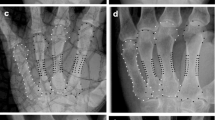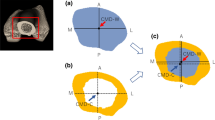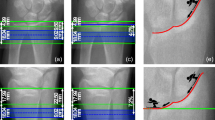Abstract
This study has been undertaken in order to describe the bone mass distribution of the dry human radius via dual x-ray absorptiometry (DXA) with a Norland XR-800 densitometer machine. A sample of 39 dry radius bones was used. Two projections were made: antero-posterior and lateral, and five regions of interest were selected. The bone densities and the bone mineral contents of the various regions of the radius in the two projections were compared using Student’s t tests for paired samples, with statistically significant differences being found in all of the values, except in the proximal extremity (P Ext). The area of greatest bone mineral content (BMC) was the medial diaphysis (M Diaph), followed by the distal extremity (D Ext), with the lowest value being found in the proximal extremity (P Ext). As for bone mineral density (BMD), a great symmetry is observed if we take the mean point of the longitudinal axis as a reference, with it being distributed from highest to lowest from the central part to the extremities. A correlation study of the BMD and BMC values between the segments themselves and with the total, in both positions, provides us with a high correlation (p ≤ 0.01), with the highest correlation value being found for the proximal diaphysis (P Diaph) region, indicating the heterogeneous nature of the distribution of the radius bone mass. Bone densitometry via DXA is useful in order to establish an overview of the structural construction of the human radius.






Similar content being viewed by others
References
Aguado-Henche S, Rodríguez Torres R, Clemente de Arriba C, Gómez Pellico L (2008) Total and regional bone mineral content in healthy Spanish subjects by dual-energy X-ray absorptiometry. Skelet Radiol 37(11):1025–1032. https://doi.org/10.1007/s00256-008-0519-3
Bossío N, Capiglioni R (2015) Densitometría Mineral Ósea por Tomografía Computada. RAAO LIV(2):19–22
Wolff J (1892) The law of bone remodelling (Das Gesetz der transformationder knochen, Kirchwald). Springer, Berlin
Tanck E, Homminga J, Van Lente GH, Huiskes R (2001) Increase in bone volume fraction precedes architectural adaptation in growing bone. Bone 28:650–654
Heinonen A, Mckay HA, Whitall KP, Forster BB, Khan KM (2001) Muscle cross-sectional area is associated with specific site of bone in prepubertal girls: a quantitative magnetic resonance imaging study. Bone 29:388–392
Hsieh YF, Turner CHY (2001) Effects of loading frequency on mechanically induced bone formation. J Bone Miner Res 16:918–924
Ducher G, Jaffre C, Arlettaz A, Benhamou CL, Courteix D (2005) Effects of long-term tennis playing on the muscle-bone relationship in the dominant and nondominant forearms. Can J Appl Physiol 30:3–17
Ducher G, Courteix D, Meme S, Magni C, Viala JF, Benhamou CL (2005) Bone geometry in response to long-term tennis playing and its relationship with muscle volume: a quantitative magnetic resonance imaging study in tennis players. Bone 37:457–466
Ducher G, Prouteau S, Courteix D, Benhamou CL (2004) Cortical and trabecular bone at the forearm show different adaptation patterns in response to tennis playing. J Clin Densitom 7:399–405
Schlenker RA, Von Seggen WW (1976) The distribution of cortical and trabecular bone mass along the lengths of the radius and ulna and the implications for in vivo bone mass measurements. Calcif Tissue Int 20:41–52
Ducher G, Tournaire N, Meddahi-Pelle A, Benhamou CL, Courteix D (2006) Short-term and long-term site-specific effects of tennis playing on trabecular and cortical bone at the distal radius. J Bone Miner Metab 24:484–490
Dowthwaite JN, Flowers PP, Spadaro JA, Scerpella TA (2006) Bone geometry, density, and strength indices of the distal radius reflect loading via childhood gymnastic activity. J Clin Densitom 10(1):65–67. https://doi.org/10.1016/j.jocd.2006.10.003
Faulkner KG, McClung MR, Schmeer MS, Roberts LA, Gaither KW (1994) Densitometry of the radius using single and dual energy absorptiometry. Calcif Tissue Int 54(3):208–211. https://doi.org/10.1007/BF00301680
Who scientific group on the assessment of osteoporosis at primary health care level. Summary Meeting Report. Brussels, Belgium, 5–7 May 2004. http://www.who.int/chp/topics/Osteoporosis.pdf
Evans AL, Paggiosi MA, Eastell R, Walsh JS (2015) Bone density, microstructure and strength in obese and normal weight men and women in younger and older adulthood. J Bone Miner Res 30(5):920–928. https://doi.org/10.1002/jbmr.2407
Arruda M, Coelho MC, Moraes AB, de Paula Paranhos-Neto F, Madeira M, Farias ML, Vieira Neto L (2016) Bone mineral density and microarchitecture in patients with autosomal dominant osteopetrosis: a report of two cases. J Bone Min Res 31(3):657–662. https://doi.org/10.1002/jbmr.2715
Genant HK, Yebin Jiang J (2006) Imaging assessment of bone quality in osteoporosis. Clin Rev Bone Miner Metab 4(3):213–224
Nieto L, Moratal D, Martí-Bonmatí L, Alberich Á, Galant J (2008) Caracterización morfológica de la estructura trabecular ósea mediante resonancia magnética de alta resolución. Radiología 50:401–408
Licata AA (2015) Challenges of estimating fracture risk with DXA: changing concepts about bone strength and bone density. Aerosp Med Hum Perform 86(7):628–632. https://doi.org/10.3357/AMHP.4208.2015
Eckstein F, Kuhn V, Lochmüller EM (2004) Strength prediction of the distal radius by bone densitometry-evaluation using biomechanical tests. Ann Biomed Eng 32(3):487–503
Rausch S, Klos K, Gras F, Skulev HK, Popp A, Hofmann GO, Mückley T (2013) Utility of the cortical thickness of the distal radius as a predictor of distal-radius bone density. Arch Trauma Res 2(1):11–15. https://doi.org/10.5812/atr.10687
Aguado-Henche S, Bosch-Martín A, Spottorno-Rubio P, Rodríguez-Torres R (2012) Internal design of the dry human Ulna by DXA. Dual Energy X-Ray Absorptiometry. Published by InTech-Open Access Publisher, ISBN: 978-953-307-877-9, January 2012, pp 97–103
Gomez Pellico L, Morante Martínez P, Dankloff Mora C (1993) Definición densitométrica de la morfología estructural de huesos del esqueleto humano. Form Méd Contin XLV(1050):637
Fernández Camacho FJ, Morante Martínez P, Rodríguez Torres R, Cortés García A, Gómez Pellico L (1996) Densitometric analysis of the human calcaneus. J Anat 189:205–209
Sanchis Moysi J, Dorado C, Vicente-Rodriguez G, Milutinovic L, Garces GL, Calbet JA (2004) Inter-arm asymmetry in bone mineral content and bone area in postmenopausal recreational tennis players. Maturitas 48(3):289–298. https://doi.org/10.1016/j.maturitas.2004.03.008
Sanchis Moysi J, Vicente-Rodriguez G, Serrano JA, Calbet JAL, Dorado C (2003) The effect of tennis participation on bone mass is better retained in male than female master tennis players. In: Kahn J-F, Lees A, Maynard I (eds) Science and racket sports III. Routledge, London
Haapasalo H, Kontulainen S, Sievanen H, Kannus P, Järvinen M, Vuori I (2000) Exercise-induced bone gain is due to enlargement in bone size without a change in volumetric bone density: a peripheral quantitative computed tomography study of the upper arms of male tennis players. Bone 27(3):351–357
Bass SL, Saxon L, Daly RM, Turner CH, Robling AG, Seeman E, Stuckey S (2002) The effect of mechanical loading on the size and shape of bone in pre-, peri-, and postpubertal girls: a study in tennis players. J Bone Miner Res 17:2274–2280
Kontulainen S, Sievänen H, Kannus P, Pasanen M, Vuori I (2002) Effect of long-term impact-loading on mass, size, and estimated strength of humerus and radius of female racquet-sports players: a peripheral quantitative computed tomography study between young and old starters and controls. J Bone Miner Res 17:2281–2289
Nara-Ashizawa N, Liu LJ, Higuchi T, Tokuyama K, Hayashi K, Shirasaki Y, Amagai H, Saitoh S (2002) Paradoxical adaptation of mature radius to unilateral use in tennis playing. Bone 30(4):619–623
Ashizawa N, Nonaka K, Michikami S, Mizuki T, Amagai H, Tokuyama K, Suzuki M (1999) Tomographical description of tennis-loaded radius: reciprocal relation between bone size and volumetric BMD. J Appl Physiol 86(4):1347–1351. https://doi.org/10.1152/jappl.1999.86.4.1347
Aguado-Henche S, Clemente de Arriba C, Carrascosa-Sánchez J (2015) Densitometric analysis of the human ulna. Int J Morphol 33(3):902–907
Ammann P, Rizzoli R (2003) Bone strength and its determinants. Osteoporos Int 14(Suppl 3):S13–S18. https://doi.org/10.1007/s00198-002-1345-4
Anatomia G (1992) Williams & Warwick. Tomo 1. Churchill Livingstone, Edinburgh
Serrano de la Cruz Fernández MJ (2008) Fracturas distales de radio. Clasificación. Tratamiento conservador. Rev Esp Cir Osteoartic 46(236):141–154
Schalamon J, Dampf S, Singer G, Ainoedhofer H, Petnehazy T, Hoellwarth M, Saxena AK (2011) Evaluation of fractures in children and adolescents in a level I Trauma Center in Austria. J Trauma 71(2):E19–E25. https://doi.org/10.1097/TA.0b013e3181f8a903
Author information
Authors and Affiliations
Corresponding author
Ethics declarations
Conflict of interest
Aguado-Henche S, Morante MArtínez P, Clemente de Arriba C and Cristóbal-Aguado S declare that they have no conflict of interest.
Rights and permissions
About this article
Cite this article
Aguado-Henche, S., Morante-Martínez, P., Cristóbal-Aguado, S. et al. Study of human radius construction systematics: evaluation by DXA in dry bone. Eur J Orthop Surg Traumatol 29, 389–396 (2019). https://doi.org/10.1007/s00590-018-2311-y
Received:
Accepted:
Published:
Issue Date:
DOI: https://doi.org/10.1007/s00590-018-2311-y




